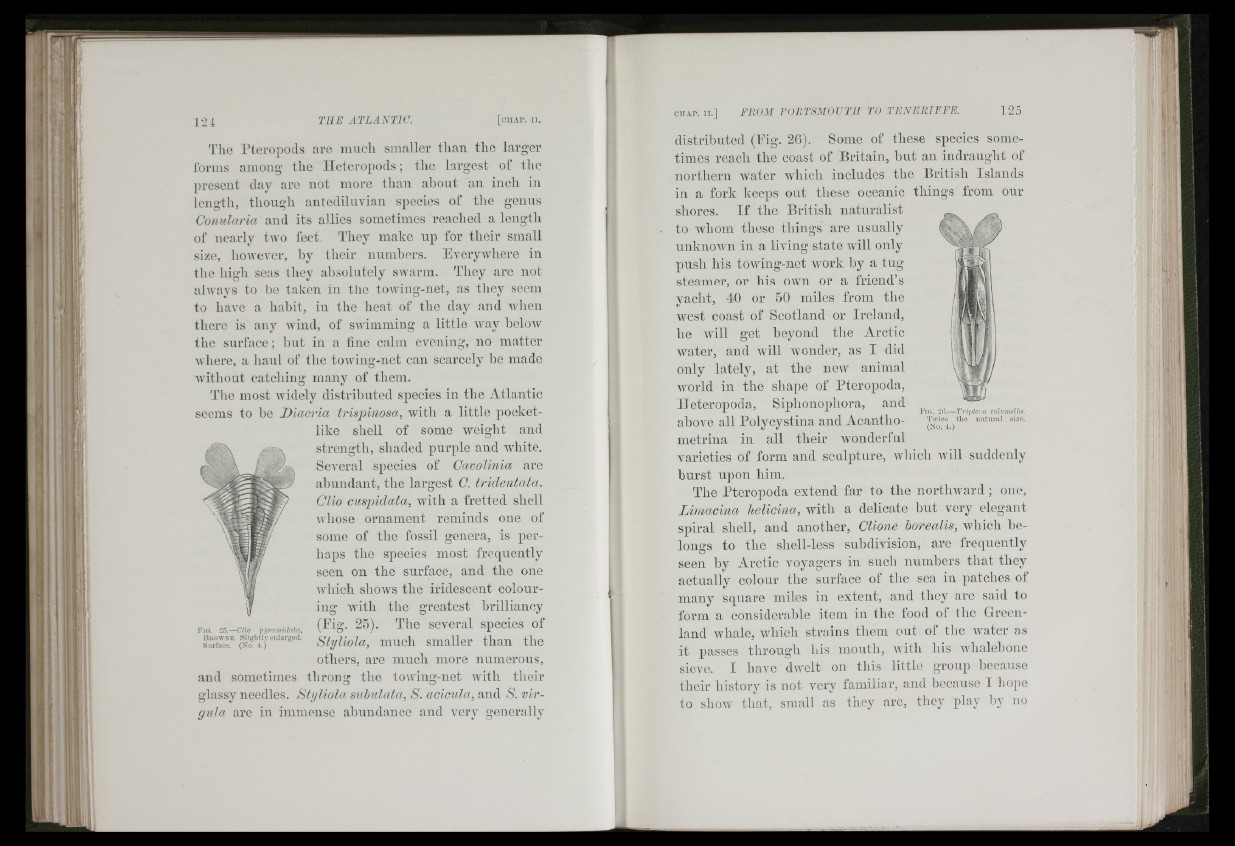
; I rf.\
\ ;
Hki '
124 THE ATLANTIC. [ c h a p . II.
The rteropods are much smaller than the larger
forms among the lieteropods; the largest of the
present day arc not more tlian ahout an inch in
length, though antediluvian species of tlie genus
Conularia and its allies sometimes reached a length
of nearly two feet. They make up for tlieir small
size, however, hy tlieir nunihers. Everyivliere in
the high seas they ahsolutely swarm. They are not
always to he taken in the tmving-net, as they seem
to have a liahit, in the lieat of the day and Avlien
there is any wind, of swimming a little ivay below
the surface; but iu a fine calm evening, no matter
Avliere, a haul of the towing-net can scarcely be made
Avitliout catcliing many of them.
The most widely distributed species in the Atlantic
seems to be JDlacria trisqiinosa, Avitli a little pocketlike
shell of some AA^eiglit and
strength, shaded purple and vdiite.
Several species of CavoUnia are
abundant, the largest C. tridentata.
Clio cuspidata, Avitb a fretted shell
Avliose ornament reminds one of
some of the fossil genera, is perhaps
the species most frequently
seen on the surface, and the one
Avhich shows the iridescent colouring
Avith the greatest hrilliancy
(Eig. 25). The se\'eral species of
Stijliola, much smaller than the
others, are much more numerous,
F i g . 2 5 .— C l i o p y r a m i d o . t a ,
Bkoayxe. Slightly enlarged.
Surface. (No. 4.)
and sometimes throng the towing-net Avith their
glassy needles. StyUola subidata, S. acicula, and S. vir-
gula are in immense ahundance and A'ery generally
CHAP. I I .] FROM RORTSMOUTI i TO TENERIFFE. 125
distributed (Eig. 26). Some of these species sometimes
reach the coast of Britain, hut an indraught of
northern Avater Avhich includes the British Islands
in a fork keeps out these oceanic things from our
shores. I f the British naturalist
to Avbom these things are usually
unknoAvn in a living state Avill only
push his toAving-net AVork hy a tug
steamer, or his own or a friend’s
yacht, 40 or 50 miles from the
west coast of Scotland or Ireland,
he Avill get heyond the Arctic
Avater, and Avill Avonder, as I did
only lately, at the nCAV animal
Avorld in the shape of Pteropoda,
Heteropoda, Siphonophora, and
ahove all Polycystina and Acantho-
F i g . 2 0 .— T r i p t e r a c o h im e l l a .
Twice th e imtuial size.
(N o . 4 . )
metrina in all their Avonderful
varieties of form and sculpture, Avliich Avill suddenly
hurst upon him.
The Pteropoda extend far to the nortliAvard ; one,
Limacina helicina, Avith a delicate hut very elegant
spiral shell, and another, CUone borealis, AA'hich belongs
to the shell-less subdivision, are frequently
seen by ilrctic voyagers in such numbers tbat they
actually colour tbe surface of the sea in patches of
many square miles in extent, and they are said to
form a considerable item in the food of the Greenland
Avliale, AAdiich straius them out of the Avater as
it passes tlii’ougli bis inoutli, Avitli liis Avlialebone
sieve. I have dwelt on tbis little group because
their history is not very familiar, and because I hope
to slioAV that, small as they are, they play by no
I i i